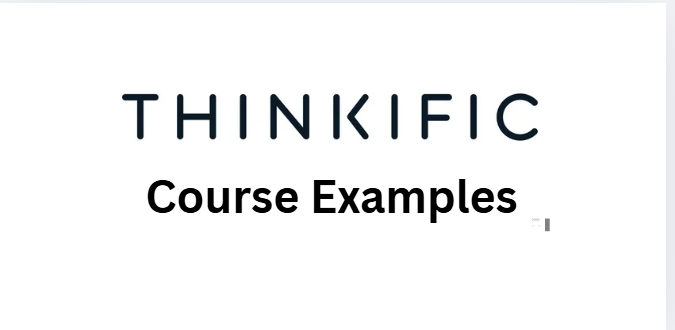If you’re wondering what makes some online courses really stand out on Thinkific, the kind that attract hundreds of students, get glowing reviews, and keep selling long after launch, this post is for you.
Because here’s the truth: It’s not just about uploading videos or creating a curriculum. The most successful Thinkific courses in 2025 combine great content, smart design, and human connection.
In this guide, we’ll look at real examples of Thinkific courses that work, and break down exactly why they succeed.
Whether you’re planning your first course or improving an existing one, these insights will help you create a course your students love (and that keeps earning revenue year after year).
Why Creators Choose Thinkific
Before getting into examples, let’s talk about why Thinkific remains one of the top course platforms in 2025.
Thinkific is built around one big idea:
Give creators full control over their courses, without needing to code or hire developers.
It’s clean, flexible, and built for growth.
Here’s what makes it so popular:
- Drag-and-drop builder: Easy to structure modules and lessons
- Custom branding: Make your course site look like you
- Student engagement tools: Quizzes, surveys, discussions, certificates
- Flexible pricing options: Free courses, one-time payments, subscriptions, or bundles
- Community features: Build student connections directly inside Thinkific
That’s why you’ll find everything from personal finance academies to language schools and corporate training programs thriving on Thinkific.
Now let’s look at some real examples.
1) YOUR PT: Professional personal-training courses
YourPT built a professional, niche training product (personal training business & advanced PT skills). This approach is great for niche vocational training where students need concrete, job-applicable outcomes.
2) Intelligensa: Positive handling & safety training
Intelligensa offers short, role-specific compliance and safety courses (e.g., Positive Handling), ideal for organizations that need blended delivery. Their Thinkific site bundles short courses for staff training and shows how organizations can deploy micro-courses to scale training across teams.
3) Coding Kids: Youth coding & micro-degrees
Coding Kids uses Thinkific to host a set of structured programs (Game Design Micro Degree, Intro to Web Development, Python courses). They combine clear pricing per program, lesson counts, and a modular pathway that parents and schools can follow. This format sells because the value is easy to understand.
4) AWeber: 24/7 Email Marketing Master Class
Email tool AWeber hosts a Thinkific course that helps users get ROI from the product. Their approach is product-led education + on-platform hosting.This is a textbook example of using Thinkific for customer education and activation.
5) Unleash Your Potential Ltd: NLP & coaching diplomas
This Thinkific-powered site sells multi-course diplomas and bundle offers, a high-touch certificate experience implemented with Thinkific’s course and sales features. It’s a good model if you want to combine live in-person components with on-demand content.
6) Lili’s School: Beauty and technician training
Lili’s School uses Thinkific to sell professional beauty courses and productized skill packages. The site shows multiple courses, tiered pricing, and free previews, all the elements that help prospective students evaluate fit and value quickly.
7) DOT Courses: Legal & immigration training
DOT Courses provides specific legal/immigration training modules hosted on Thinkific. Using Thinkific for specialist, compliance-related content is common: short courses, clear pricing, and quick purchase paths. These selling points reduce friction for busy professionals who need discrete skill modules.
What These Courses Have in Common
While the topics differ, from piano to copywriting to drone training, every successful Thinkific course shares these core traits:
1. A Clear Transformation
They don’t just teach, they change something for the student.
Every marketing message and lesson leads toward a specific result.
2. Consistent Design and Branding
Good visuals make a course feel credible. These creators use consistent colors, fonts, and tone, matching their website and marketing materials.
3. Active Student Engagement
Each course includes interactive or community elements: challenges, comments, or live calls.
4. Real Outcomes
They focus on what students can do by the end, not just what they’ll “learn.”
5. Smart Automation
From welcome emails to certificate delivery, Thinkific’s automation helps these creators scale their teaching without losing the personal touch.
Thinkific Features That Support Successful Courses (2025)
If you’re planning to build a successful course like the examples above, focus on using Thinkific’s newest features effectively:
- Communities: Build a private space for student discussions
- Drip content: Release lessons over time to keep motivation high
- Bundles and memberships: Sell multiple courses or create long-term programs
- Certificates: Reward student progress
- Integrations: Connect with email tools like ConvertKit or ActiveCampaign
- Analytics: Track engagement and completion rates
Together, these tools help you create a course that feels professional and runs smoothly.
Conclusion
You don’t need a fancy studio or a huge marketing budget to create a Thinkific course that sells. What you need is clarity, a clear goal, a clear audience, and a clear learning journey. Every successful creator on Thinkific started with a simple idea: “What transformation can I help people achieve?”
Once you know that, Thinkific gives you everything you need, structure, automation, community, and design, to bring it to life. So take inspiration from these real-world examples, pick your niche, and start building your own course success story.













